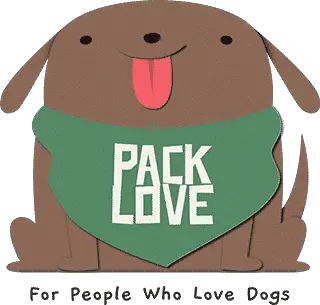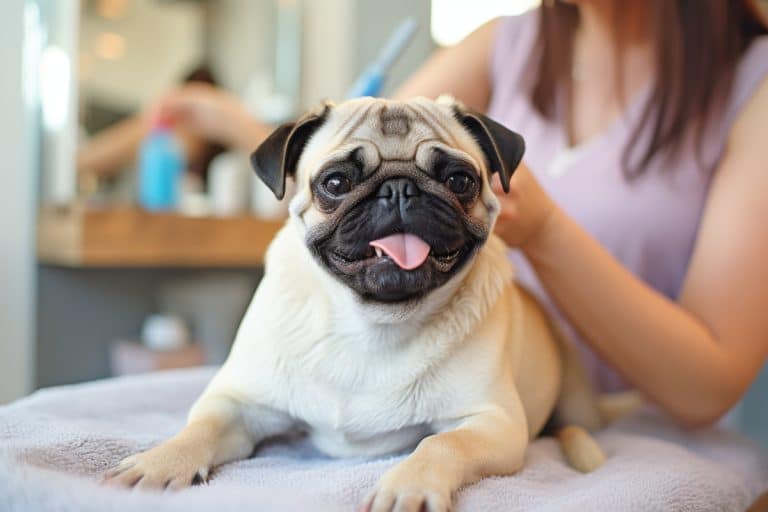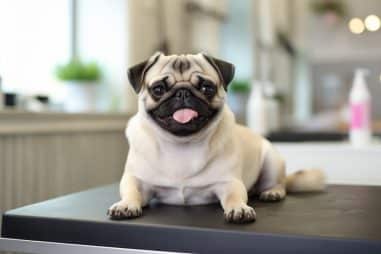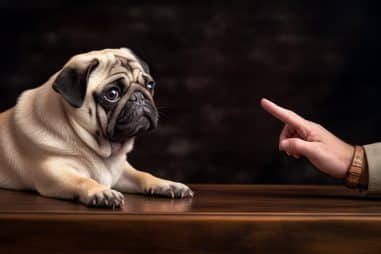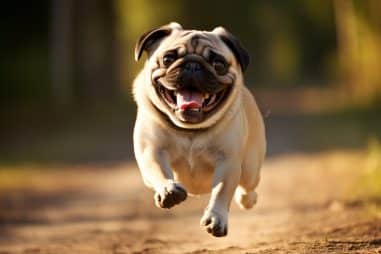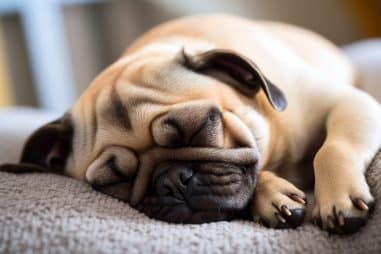Pugs are adorable, with their cute wrinkles and charming expressions. But those lovely features come with some grooming needs. If you own a pug or are thinking of getting one, understanding their grooming requirements is essential. This article is here to guide you through every step, ensuring that your pug is not only looking its best but also feeling its top-notch self.
Do Pugs Need Grooming?
There’s a myth that short-haired dogs like pugs don’t need grooming. That’s not true. Pugs shed. And they shed a lot! Regular grooming helps manage this shedding and ensures that your home doesn’t get covered in a layer of pug fur.
Moreover, pugs have a double coat. This means they have a soft undercoat beneath their rough top coat. Regular grooming helps keep both these layers healthy. Plus, it’s a great way for you and your pug to bond.
Why Grooming Is Essential for Pugs
Taking good care of your pug’s coat and skin is more than just about looks. It’s about their health and comfort. Pugs can face various issues if not groomed regularly.
- Maintaining Health: Regular grooming helps to remove dirt, dander, and loose hairs that can cause skin problems. It also gives you a chance to check for signs of infections or other health issues.
- Preventing Issues: Pugs are known for their deep wrinkles, especially on their faces. These wrinkles can become breeding grounds for bacteria if not cleaned. Regular grooming ensures these folds are dry and clean.
- Comfort: Imagine wearing a sweater in the hot summer sun. That’s how a pug might feel with a thick, unkempt coat. Regular grooming ensures they are comfortable in all seasons.
Choosing the Right Grooming Tools
Using the right tools can make grooming a breeze. Here’s a list of essential tools for grooming pugs and a brief guide on how to use each of them:
- Rubber Grooming Mitt or Bristle Brush:
- Usage: Ideal for pugs due to their short coat. Use the mitt or brush to stroke in the direction of hair growth. This helps remove loose hairs and stimulates the skin. It’s also great for massaging and increasing blood circulation.
- Mild Dog Shampoo:
- Usage: Wet your pug’s coat with lukewarm water. Apply a small amount of shampoo, lather, and gently massage it in. Rinse thoroughly to ensure no residue remains.
- Dog Conditioner (optional):
- Usage: After shampooing, apply conditioner to make the coat soft and shiny. Rinse well.
- Cotton Balls and Vet-Approved Ear-Cleaning Solution:
- Usage: Soak the cotton ball in the solution and gently wipe the inner part of the ear. Avoid inserting anything deep into the ear canal.
- Toothbrush and Dog Toothpaste:
- Usage: Gently brush your pug’s teeth in a circular motion. Focus on the gum line and ensure you reach the back teeth.
- Nail Clippers (specifically for dogs):
- Usage: Hold your pug’s paw firmly but gently. Clip the tip of each nail, being careful not to cut into the quick (the pinkish part inside the nail). If you’re unsure, just trim the very tips.
- Styptic Powder:
- Usage: In case you accidentally cut into the quick of the nail and it starts bleeding, apply a pinch of styptic powder to stop the bleeding.
- Rounded-Tip Scissors:
- Usage: These are safe for trimming the fur around your pug’s paws and face. Ensure the pug is calm, and carefully trim any excess fur.
- Towels:
- Usage: Always have a soft towel handy to dry your pug after a bath. Gently pat dry, ensuring you dry the areas between the wrinkles thoroughly.
- Wipes:
- Usage: These are useful for quick cleanups, especially for the face and wrinkles. Ensure you use wipes that are safe for dogs.
Remember, while these tools are essential, it’s equally important to create a calm environment during grooming sessions. This ensures that your pug feels safe and enjoys the process. If you’re ever unsure about a particular grooming task, consult with a professional groomer or a vet for guidance.
How to Brush a Pug
Brushing your pug is more than just running a brush over its back. Here’s how to do it right:
- Choose a Calm Time: Find a quiet spot and ensure your pug is relaxed.
- Start Gently: Begin with the head and move towards the tail. Always brush in the direction of hair growth.
- Be Thorough: Pay special attention to areas that shed more, like the neck and thighs. Also, remember those adorable wrinkles. Gently clean them using a damp cloth.
Do Pugs Smell?
All dogs have a natural odor. However, if you notice a strong smell from your pug, it might be a sign of a problem. Regular grooming can help identify the cause of the smell and address it.
For instance, pugs are prone to ear infections. If you notice a strong odor coming from the ears, it’s time to visit the vet. Similarly, those cute wrinkles can trap dirt and moisture, leading to a musty smell. Regular cleaning can prevent this.
How Often Should You Bathe a Pug?
Bathing your pug too often can strip its skin of natural oils. A good rule of thumb is to bathe your pug once every 3-4 weeks (or about 12-16 times a year). However, if your pug loves playing in the mud, you might need to bathe it more often.
Always use lukewarm water (around 38°C or 100°F) and ensure you rinse out all the shampoo. After the bath, dry your pug thoroughly, especially in the wrinkles.
How to Clean a Pug’s Ears
Cleaning your pug’s ears is crucial to prevent infections. Here’s how:
- Check Regularly: Look for signs like redness, bad odor, or excessive wax.
- Use the Right Solution: Pour a vet-approved cleaning solution on a cotton ball.
- Clean Gently: Wipe the inner part of the ear without going too deep.
Remember, if you’re unsure or if your pug seems uncomfortable, it’s best to consult a vet.
How to Trim Pugs’ Paws
Pugs have furry paws. Trimming them ensures they don’t slip on smooth surfaces.
- Hold the Paw Firmly: But be gentle.
- Use the Right Scissors: Rounded-tip scissors are the safest.
- Trim Carefully: Cut the fur that sticks out from between the pads.
How to Cut Pugs’ Nails
Overgrown nails can be painful for your pug. Here’s how to trim them:
-
- Use a Dog Nail Clipper: These are designed to cut dog nails safely.
- Clip Small Bits: Avoid cutting into the quick, the pinkish area inside the nail.
- Reward Your Pug: Give them a treat after trimming. This makes them associate nail cutting with good things.
How Often Should a Pug Be Groomed?
Ideally, you should brush your pug every 2-3 days. This helps manage shedding and ensures their coat is tangle-free. As for other grooming tasks like bathing, ear cleaning, and nail trimming, once every 3-4 weeks is a good schedule.
Dental Care for Pugs
Your pug’s teeth need care too. Dental problems can lead to other health issues.
- Brushing: Use a dog toothbrush and toothpaste. Brush at least 2-3 times a week.
- Dental Treats: These can help clean your pug’s teeth and freshen their breath.
- Regular Vet Checkups: This ensures any dental problems are caught early.
Conclusion
Taking care of your pug’s grooming needs is an essential part of being a responsible pet owner. It ensures that your pug is comfortable, healthy, and happy. Plus, it’s a great way for you and your pug to bond. So, grab those grooming tools and give your pug the care it deserves!
